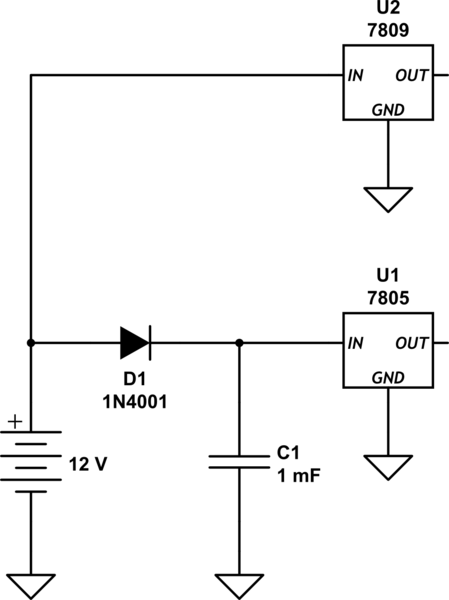You can't power this circuit from two independent (isolated) power supplies. You must have a common ground for this circuit to function, and once you have the grounds of two different power supplies connected, it is no different and no more independent than what you already have.
The TIP120 only turns on if there is current flowing through the base and out the emitter. For current to flow, the base voltage must share a common ground with the motor drive voltage.
To use two isolated power supplies would require something like an opto-isolator between your ATTiny and the transistor base.
Different voltage potentials with a common ground are, well, different voltage potentials with common ground. There is nothing you will gain (and indeed, it will be functionally equivalent) by any circuit you might use to derive two different voltages from a single power supply.
So yes, you can split your 12V power supply into a 9V and a 5V power supply. You would do so by using an LM7805 and LM7809.
The only way would require creating an isolated voltage source using something like a flyback converter and a transformer, but this is far more advanced than is even reasonable to build for something like this.
I promise you that your problem has nothing to do with how you're getting the 5V rail from a single power source, and has everything to do with your complete lack of any capacitance anywhere. You don't even have a ceramic capacitor for your microcontroller.
When the motor turns on, it causes a voltage sag that drives the 7805 out of regulation (the voltage drops briefly) and this triggers the brown-out detection on the ATTiny, causing it to reset itself. Additionally, the 7805 isn't even stable without input and output capacitance in the first place, so I'm amazed the circuit worked at all.
Either way, whether it is with a 9V battery or a 12V power brick, you need some bulk capacitance there to handle the large current spikes switching on the motor will demand.
That will be far far easier than any possible way to generate an isolated output from an existing power supply.
But if you really want two power supplies... just power the motor from the 12V power brick and power the microcontroller and the 7805 from a 9V battery, with their grounds joined. Batteries work as isolated power supplies in a pinch, albeit ones with limited capacity.
Another note: There is no point in powering the motor from a 12V power supply, at least with the circuit as you have it now. The TIP120 is an NPN darlington transistor, yet you're using it as a high-side switch. For base current to flow out of the emitter, the voltage at the emitter must be less than the base voltage minus 0.7V for the base voltage drop. This means you won't ever be able to turn on the transistor more than a few volts (or less) at the emitter, and that is the most the motor will see. The rest of the 12V will be dropped across the transistor, making it get very hot very fast.
You need to use NPN transistors as low-side switches. Connect the collector the motor's negative lead, and connect the emitter to ground. This will let you properly power the motor from 12V.
Final note: motors are noisy. The pull-up on the reset pin on AVRs is usually pretty weak and it is possible that noise could couple in and trigger a spurious reset. You should consider using a stronger external pull-up resistor, like 10kΩ to VCC on the reset pin (pin 1).
 Instead of using two batteries/ supplies, I tried to use the same battery for powering my microcontroller and Load and I am getting very strange behavior. I set the blink time to 2sec but here with this schematic(below), I observe random switching.
Instead of using two batteries/ supplies, I tried to use the same battery for powering my microcontroller and Load and I am getting very strange behavior. I set the blink time to 2sec but here with this schematic(below), I observe random switching.



